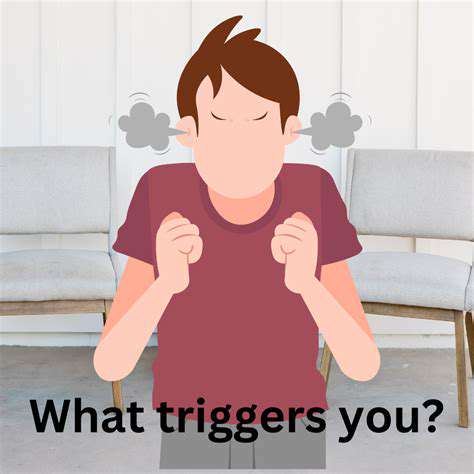What to do if your dog shows symptoms of anxiety
Assessing the Potential Triggers for Your Dog's Anxiety

Understanding the Scope of Potential Triggers
Spotting what sets off your dog's anxiety requires careful observation and patience. Every dog has unique stress signals that owners must learn to recognize. It's not just about obvious events like thunderstorms, but also subtle changes in routine or environment that might unsettle your pet. Paying attention to these details helps create a complete picture of your dog's emotional landscape.
Keeping a behavior journal can reveal patterns you might otherwise miss. Note dates, times, and circumstances surrounding anxious episodes to identify recurring themes. This hands-on approach often uncovers surprising connections between seemingly unrelated events and your dog's stress responses.
Evaluating Internal Factors
Your dog's physical health significantly influences their emotional state. Issues like chronic pain, digestive problems, or hormonal imbalances can manifest as anxiety. A thorough veterinary checkup should always be the first step when addressing behavioral concerns.
Consider your dog's basic needs too. A tired dog is often a calm dog - inadequate exercise ranks among the top preventable causes of canine anxiety. Similarly, mental stimulation through puzzle toys or training sessions can prevent nervous energy from building up.
Analyzing External Factors
Dogs experience the world through their senses far more intensely than we do. Common household items like air fresheners or cleaning products might contain scents that distress sensitive dogs. Even the hum of electronics or flickering lights could trigger unease in some pets. Walk through your home from your dog's perspective to spot potential stress sources.
Identifying Key Stress Indicators
Learn to read your dog's body language like a book. Subtle signs like lip licking, yawning, or avoiding eye contact often precede more obvious anxiety displays. These early warnings allow you to intervene before full-blown panic sets in.
Notice how your dog's stress responses change in different situations. Some might freeze when frightened, while others become hyperactive. Recognizing your dog's personal stress signature helps tailor your response appropriately.
Developing Calming Strategies
Create a toolkit of proven relaxation methods for your dog. Classical conditioning can work wonders - pairing scary noises with high-value treats helps rebuild positive associations. Start with very low exposure to triggers while your dog remains calm, gradually increasing intensity as they build confidence.
Teaching a solid settle command provides an invaluable coping mechanism during stressful events. Practice during calm moments first, rewarding relaxed behavior until your dog can maintain composure even in challenging situations.
Prioritizing and Implementing Solutions
Tackle one trigger at a time, starting with the most manageable. Quick wins build confidence for both you and your dog. For persistent issues, consider consulting a certified behaviorist who can design a customized desensitization program.
Implementing Effective Coping Strategies for Your Anxious Dog
Understanding Your Anxious Dog
Recognizing anxiety signals requires knowing your dog's normal behavior first. Baseline knowledge lets you spot deviations that indicate stress. Many anxious behaviors actually represent normal canine communication - it's the frequency and context that make them problematic.
Watch for displacement behaviors - actions like sudden scratching or sniffing that seem out of context. These often signal internal conflict or discomfort. Learning this canine body language helps you respond appropriately before anxiety escalates.
Identifying the Root Cause of Anxiety
Anxiety rarely has a single cause. More often, it's a perfect storm of genetic predisposition, early experiences, and current environment. Puppies who missed critical socialization periods often develop anxiety about novel situations later in life. Understanding this developmental background helps explain current behaviors.
Medical issues frequently masquerade as anxiety. Thyroid imbalances, vision/hearing loss, or neurological conditions can all trigger anxious behaviors. Always rule out physical causes before assuming purely psychological origins.
Creating a Safe and Predictable Environment
Dogs thrive on predictability. Establish clear routines for feeding, walks, and playtime to provide structural security. A safe zone stocked with favorite toys and familiar scents gives your dog an instant retreat when overwhelmed. Teach children and guests to respect this sanctuary space.
Manage your dog's environment proactively. If they panic during storms, create a white noise buffer in their safe space before bad weather hits. Prevention often proves easier than intervention once anxiety takes hold.
Utilizing Calming Techniques
Physical contact, when welcomed by the dog, can lower stress hormones. Learn proper TTouch or therapeutic massage techniques to help your pet relax. Many dogs respond well to pressure wraps that provide gentle, constant physical reassurance.
Food-dispensing toys serve dual purposes - they distract from stressors while providing mental stimulation. The act of chewing releases natural calming chemicals in a dog's brain, making appropriate chew items valuable anxiety tools.
Implementing Positive Reinforcement Training
Reward-based training builds confidence along with skills. Shaping calm behavior through incremental rewards creates lasting change more effectively than punishing anxious displays. Capture and reward moments of relaxation throughout the day to reinforce this desirable state.
Teach your dog to make choices rather than react instinctively. Offering simple sit or touch commands during mild stress gives them an alternative to panic. This sense of control significantly reduces anxiety over time.
Seeking Professional Guidance
When home efforts plateau, professional input can provide breakthroughs. Certified Applied Animal Behaviorists (CAAB) have advanced training in treating complex anxiety cases. They can identify subtle triggers and design targeted intervention plans.
Modern veterinary behaviorists combine medical and behavioral approaches. They might prescribe short-term anti-anxiety medication to facilitate training breakthroughs in severe cases, always combined with behavior modification programs.
Lifestyle Adjustments and Dietary Considerations
Regular aerobic exercise regulates brain chemistry much like antidepressants do in humans. A proper exercise regimen often reduces anxiety as effectively as medication for many dogs. Tailor activities to your dog's age and physical condition for maximum benefit.
Nutritional support can complement behavioral approaches. Some dogs benefit from tryptophan-rich diets or supplements that support neurotransmitter balance. Always consult your vet before making dietary changes for behavioral purposes.
Lifestyle Modifications and Environmental Adjustments

Lifestyle Modifications for a Healthier Dog
Small daily improvements create significant long-term benefits for anxious dogs. Consistency matters more than intensity when establishing new routines. Gradual behavior modification allows dogs to adapt without additional stress.
Incorporate mental exercise equal to physical activity. Nose work games, food puzzles, and trick training all provide cognitive challenges that tire dogs mentally. A mentally tired dog has less energy for anxious behaviors.
Environmental Factors Affecting Canine Anxiety
Home environments profoundly impact anxious dogs. Hard surfaces amplify noises that sensitive dogs find distressing. Area rugs, sound-absorbing panels, or white noise machines can create a more soothing acoustic environment.
Visual stimulation also affects anxiety levels. Dogs kept in high-traffic areas with constant activity may benefit from a quieter space with limited visual access to stressful stimuli. Strategic furniture placement can create sight barriers that reduce environmental pressure.
Dietary Habits and Nutritional Support
Meal timing and content influence anxiety. Smaller, more frequent meals help maintain steady blood sugar levels, preventing energy crashes that can heighten stress responses. High-quality protein sources support neurotransmitter production essential for emotional regulation.
Some dogs show marked improvement with specific nutritional supplements. Omega-3 fatty acids, probiotics, and certain herbal blends may help modulate stress responses. Always introduce new supplements gradually under veterinary supervision.
Physical Activity and Stress Relief
Exercise type matters as much as duration. Leisurely sniff walks allow anxious dogs to gather environmental information at their own pace, building confidence. For many anxious dogs, sniffing provides greater stress relief than vigorous exercise.
Water therapy offers low-impact exercise that many anxious dogs enjoy. The resistance of water provides physical challenge while the buoyancy creates a calming, weightless sensation. This can be particularly helpful for older anxious dogs with joint issues.
Stress Management Through Routine
Predictable schedules reduce decision fatigue for anxious dogs. Knowing what comes next eliminates uncertainty that fuels anxiety. Visual cues like specific leashes or food bowls can signal upcoming activities, helping dogs mentally prepare.
Wind-down routines before stressful events help dogs transition calmly. Gentle massage, quiet time, or calming scent therapy before vet visits or storms can significantly reduce subsequent anxiety reactions.
- Storm Risks for Dogs: What Pet Owners Need to Know
- Monitor Your Dog's Behavior for a Happier Pet
- If You Notice Your Dog Acting Unusually, Here's What To Do
- Exploring the Natural Instincts of Dogs: A Deep Dive into Canine Behavior
- Tips for stopping your dog from marking indoors
- How to pick the right toys for your dog
- Tips for safely removing earwax from your dog
- Preparing your dog for grooming during summer
- Why socializing your dog is important for their health
- Tips for keeping your dog active in the winter
- How to create a stress free environment for your dog
- How often should you bathe your dog?